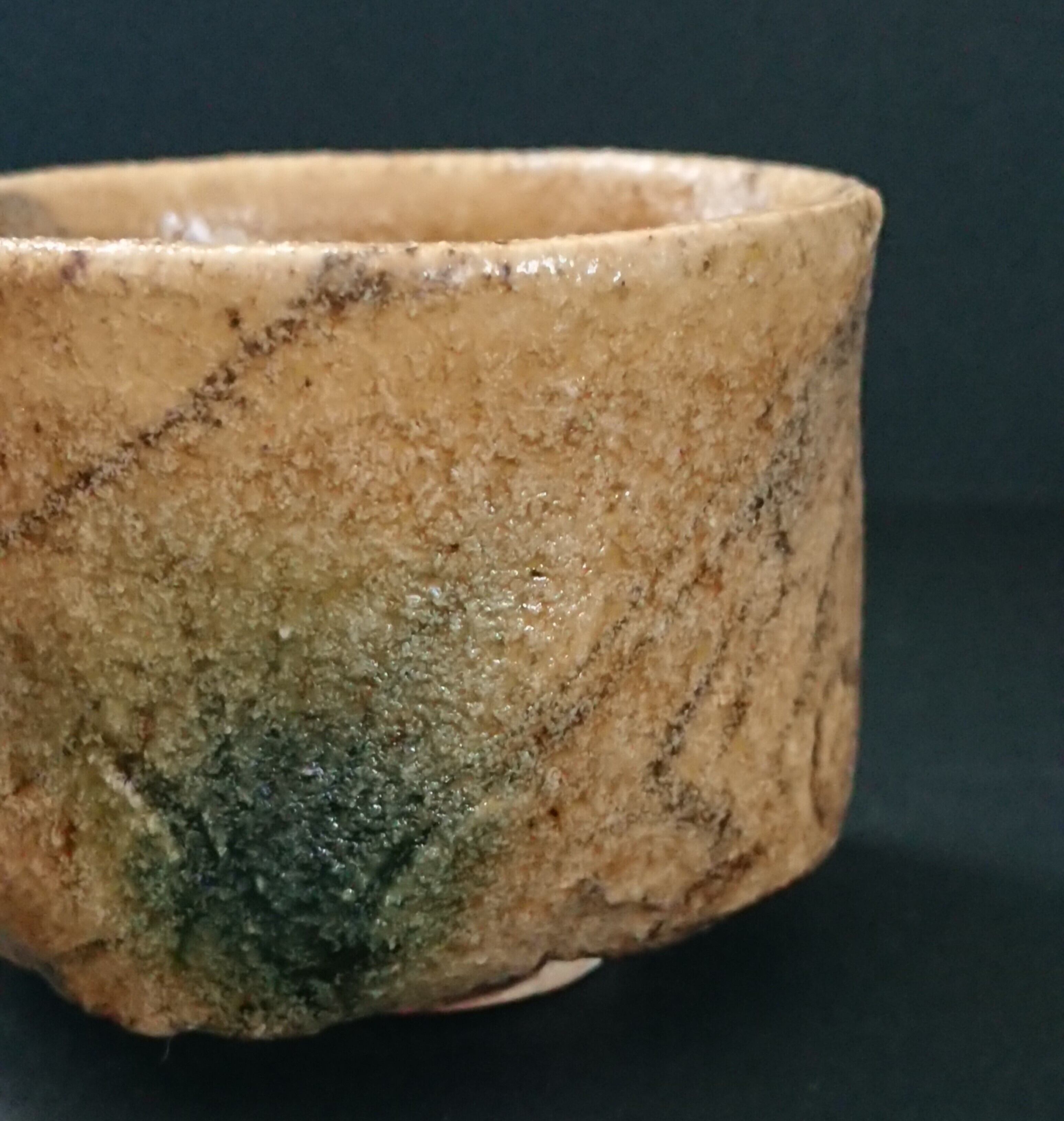








「それぞれの織部展」(the exhibition “Oribes” for them, l'exposition “Oribes” pour eux) 虎皮手黄瀬戸酒盃(kiseto sake cup, kiseto coupe à sake) 松村遷(sen,matsumura)
¥12,000 税込
SOLD OUT
別途送料がかかります。送料を確認する
《解説》「美濃物に携わる者として、やきものにまず「織部」を求めてしまいます。表現の豊かさこそが織部的だと思っていて、それを特に感じるのが弥七田と美濃伊賀です。その飄々とした軽やかさを自作に取り込みたいと突き動かされてしまいます。また、時代は下りますが、呉須赤絵や奥田潁川の筆の動き、原憲司先生の線刻のキレにも同じものを感じます。」
松村さんの織部は「軽やかさ」の感じられるところならどこにでもある汎用性をもっているようだ。だから、概念的には織部好みと対極にあるはずの黄瀬戸にもそれを取り込めば立派な織部となる。この作品では、いつも作家が黄瀬戸に用いる本沼の土に、お住まい近くの伊奈屋敷跡の土を練り込んだ。「虎皮手」は土が混ざった模様が虎の皮のようにみえることからきている。伊奈屋敷は戦国時代の武将伊奈忠次がちょうど利休自刃の年に建てた陣屋だという。黄瀬戸の生産が始まったのもちょうどこの頃だから、この土は織部の時代と二重に関わっている。写真ではわかりにくいが、クローズアップして観ると、濃い黄色の向こうの変化がとても激しい。胴紐に比べて動いている形以上に、その表情はまさに「暴れている」という形容がふさわしい。聞けば、「漫画『花の慶次』の主人公前田慶次が虎の皮を着てぐいっと飲み干す様子をイメージしたという。この方にとっていかに織部が身近な存在かよくわかる。
《黄瀬戸(yellow seto)》Kizeto(yellow seto) is accompanied by the image of Rikyu for the reason that Rikyu cherished "Kitamuki Dochingonomi Kizeto"(Kizeto that liked Kitamuki Dochin, Rikyu's master of tea), which can be said to be the prototype of Kizeto. In Momoyama pottery, which is generally oriented toward distortion, it seems to be far from the so-called Oribe style, because of its unique nature, which maintains the formality and was originally “mukouzuke”, one of the japanese tablewares. However, Kizeto, which is called “油揚手(aburagede)” in Mino, began to be produced at the same time as Setoguro, around the end of Tensho (1590). Since Rikyu died in 1591, there is almost no time when Rikyu and Kizeto overlap. Therefore, the appearance of Kizeto, which can be called “gold pottery”, coincides with the era when Oribe was active. He must have seen Kizeto imported from the same production area as Setoguro and Oribeguro, and they have excavated its several items from the remains Kyosanjo. Therefore, it is possible that Oribe used it in some way. Mr. Matsumura expressed Oribe in this sake cup by deliberately breaking the original tone of Kizeto.
《黄瀬戸(seto jaune)》Kizeto(seto jaune) est accompagné de l'image de Rikyu, parceque Rikyu chérissait "Kitamuki Dochingonomi Kizeto"( qu'aimait Kitamuki Dochin, maître de Rikyu), qui est le prototype de Kizeto. Dans la poterie de Momoyama, généralement orientée vers la
distorsion, il semble être loin du style dit Oribe, en raison de sa nature unique, qui maintient la formalité et était à l'origine "mukouzuke", l'une des vaisselles japonaises. Kizeto, qui s'appelle “油揚手(aburagede)”, a commencé à être produit en même temps que Setoguro, vers la fin de Tensho (1590). Étant donné que Rikyu s'est suicidé en 1591, il n'y a presque pas de moment où Rikyu et Kizeto coexistent. Par conséquent, l'apparition de Kizeto, qui peut être comparée à la poterie d'or, coïncide avec l'ère d'Oribe. Il doit avoir vu Kiseto expédié de la même zone de production que Setoguro et Oribeguro, et on a fouillé ses plusieurs éléments des restes Kyosanjo. Par conséquent, il est possible qu'il l'ait utilisé d'une manière ou d'une autre. M. Matsumura a exprimé cette fois Oribe en brisant délibérément le ton originel de Kiseto.
※参考
「ぐい呑み考」https://ameblo.jp/guinomikou/entry-12679100335.html
https://ameblo.jp/guinomikou/theme-10113945879.html
《作品情報》(寸法)w6.5㎝×h4.8㎝(いずれも最大値)、共箱付、新品
《販売期限》2021年7月15日迄
《お届け》御注文後に共箱をご用意いたしますので、お届けまで約三週間頂戴いたします。
-
送料・配送方法について
-
お支払い方法について
¥12,000 税込
SOLD OUT
























